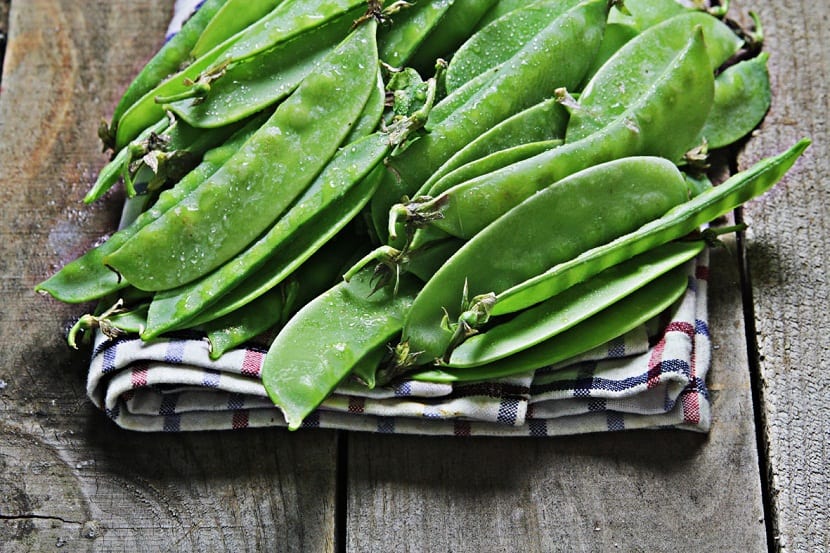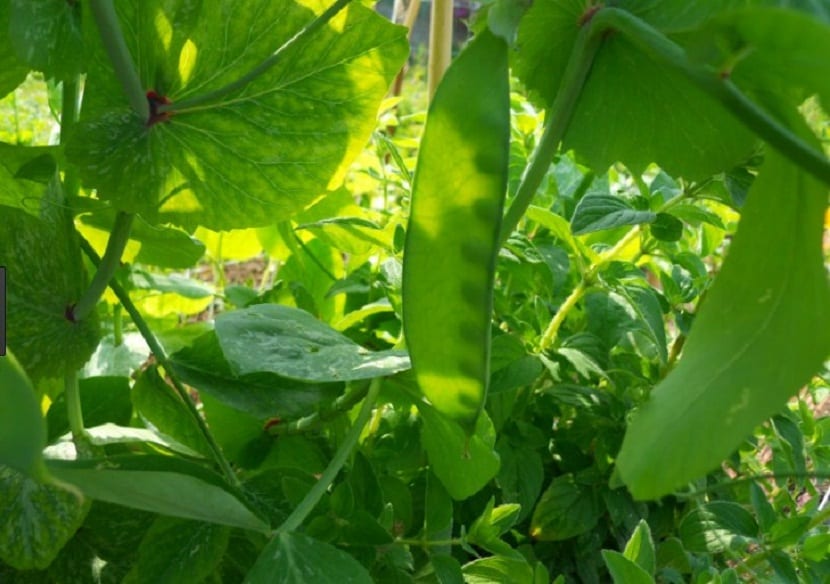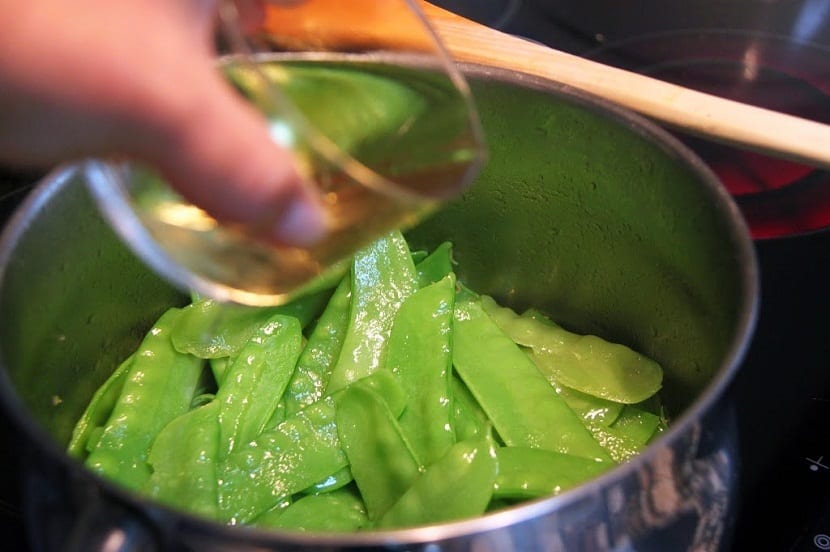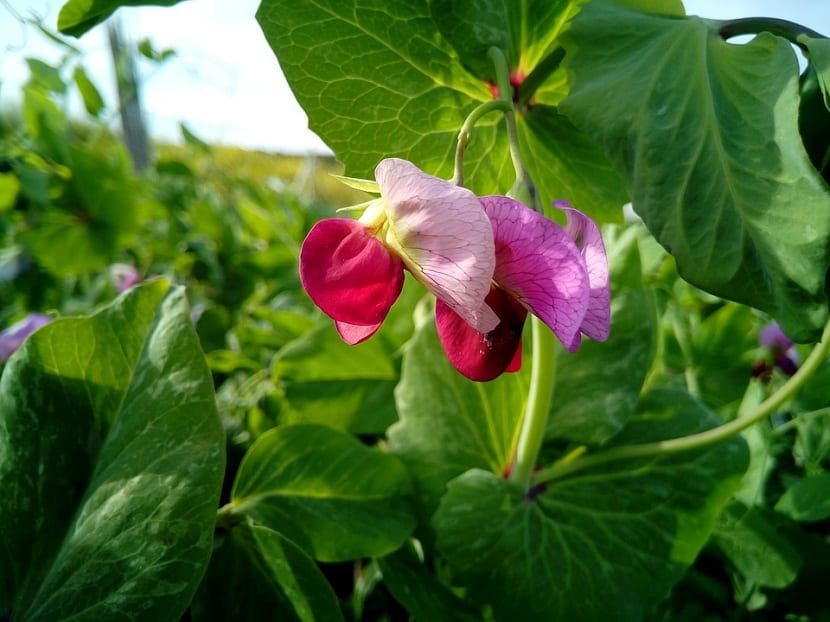
Many will ask,what are snow peas? These are small vegetables from the pea family, which occur in deep green pods and that they have quite small seeds unlike peas whose seeds are more developed, being what is consumed from this.
They are originally from the Mediterranean and Asian basin and these are vegetables of very short seasons, just a few weeks in the beginning of spring. Due to the small size of the seeds, snow peas stick with everything, They are crunchy in texture and at the same time soft with a somewhat sweet taste and a very light touch of bitterness, it is recommended that they be consumed as fresh as possible, since with the passage of days the pod becomes hard and the snow peas loses its taste.
What do you have to know before cooking the snow peas?

Recommended remove the threads which are arranged at the junction of the pods, before cooking the peas, since for many their presence is unpleasant.
The process is not complicated at all, the sheath should be held with one hand and with the help of the other, the stem is taken by the tip of it, it is stretched upwards, while the sheath is pressed down and these veins come out completely.
It is worth noting that there are those who consume it without having to remove these lateral threads, nothing happens if they are not removed, since it is a matter of taste, but remember, should be washed thoroughly.
How to cook snow peas?
There are three recommended ways to cook them, directly in hot water, steamed or sautéed. The important thing is not to overcook them, since they lose their crunchiness, which is one of their attractions.
The cooking process in water makes it possible to lower the bitter taste of snow peasHowever, this is to the taste of the diner. As soon as they are removed from the heat, the cooking should be stopped with cold water, remembering that they should be eaten al dente.
For consume them sauteedYou can cook them directly with the rest of the ingredients or if you prefer, they can be passed through boiling water for a few seconds and then sautéed.
If you want to add snow peas to stews, remember to do it almost at the end, when it is going to be ready so that they retain their crunchy texture.
It is also known by these names, bisalto, miracielo and capuchin pea
In France they call the snow peas "pois gourmant", "pois princesse" and "pois mangetout", in England they are known as "snow peas" and in Italy "taccola" and "piselli mangiatutto." The latter comes in handy, since absolutely all of this vegetable is eaten, due to its tender pod and small seeds.
The presentation is quite striking, bright green and fairly flat, with slight bumps where the seeds inside it discreetly appear and it is also quite appreciated for its flavor and texture, which is why you have to take care not to overcook them.
Snow peas are usually present in some signature dishes as part of the ingredients, although they are not the protagonists of these. It is usually consumed in salads, soups, beans and as a side to other foods.
Snow peas properties
Snow peas contain vegetable proteins, vitamin B, vitamin C, minerals such as zinc, potassium, magnesium and also fiber, provide energy and are stimulating, but they are contraindicated in people suffering from gastrointestinal disorders, that are in the middle of diets and for those who have a slow digestion.
Snow peas cultivation

From the Fabaceae family, represent a very beneficial crop for when the land is depleted after years of crops that demand a lot from the soil, such as vegetables. Snow peas facilitates the fixation of hydrogen in the substrate and helps the soil regenerate quickly.
The ideal season to grow them is spring, as soon as the extremely low temperatures subside.
They should be grown keeping a distance between one row and another of about 40 to 50 centimeters, in such a way that the development of each of the plants is facilitated. Once they reach the height about 15 centimeters The stem must be reinforced with a base or tutor so that they continue to grow upwards, this process contributes to the subsequent emergence of the pods and their collection, after two months, the plant is in full development generating pods that give to collect up to about four times.
It is not a plant that demands a lot from the soil, unless it has enough nutrientsIt deserves a lot of sun, although not in excess and it is permanently irrigated, since it does not tolerate drought. But if what you want is to have a snow peas harvest Throughout the summer, two crops should be done with a difference of three weeks between one and the other.
Let's talk about a type of snow peas, the yellow snow peas
Far from coming from a hybrid process, it is a variant of the species very old, by the way.
It is grown in the same way as peas, requires a climate of abundant freshness and not very demanding substrate, in fact, it does not tolerate soils with high acid content, it also needs a lot of sun and constant irrigation of the soil.
The most frequent pests that usually affect snow pea plantations are aphids, fungi, coleopterans and pea moths.

In addition to its nutritional properties when putting it on the table, the decorative factor in the yellow snow peas is an added value, since its bright red flowers are very showy, as are its yellow fruits.
There are currently under development, organic peas crops in greenhouses and in the town of Almería, a total of eight varieties of this vegetable that, given their qualities of total use (pods and seeds), are quite attractive.
The purpose of these controlled crops is specify the quality and importance of snow peas and of other leguminous plants in the diversification of greenhouse crops, which apparently have managed to stand out above other crops, especially the one that concerns us given its well-known properties that have even earned it the title of delicatessen.
If it is about business, in Almería the diversification of crops has been promoted in recent years, giving way to new plant species in order to open other business avenues and that is that in the cultivation of snow peas, there are not inconsiderable business opportunities and that contribute to economic development of Andalusia.
In this sense and for 2016, it was launched greenhouse cultivation (test) of 800 square meters, which contains a total of eight species whose results have been good so far, are now in the phase of collecting these for their corresponding study to determine which of the varieties are the most conducive to growing in the greenhouse .
Studies carried out by several schools together and through the application of questionnaires show that the Tirabeque is currently cultivated in small plots located in very cold areas, verifying that far from what has been said, they are also resistant in temperatures down to minus 3 degrees.
These latest data come from the conference held in the IFAPA of La Mojonera (Almería) in February of this year 2017.
